#computational fluid dynamics
Explore tagged Tumblr posts
Text
Why Tornado Alley is North American

Growing up in northwest Arkansas, I spent my share of summer nights sheltering from tornadoes. Central North America -- colloquially known as Tornado Alley -- is especially prone to violent thunderstorms and accompanying tornadoes. That's due, in part, to two geographical features: the Rocky Mountains and the Gulf of Mexico. (Image credit: G. Johnson; research credit: F. Li et al.; via Physics World) Read the full article
#atmospherics cience#CFD#computational fluid dynamics#fluid dynamics#meteorology#physics#science#surface roughness#thunderstorm#tornado#vorticity
151 notes
·
View notes
Text

this cat is learning computational fluid dynamics^ (unwillingly)
15 notes
·
View notes
Text
A class of curves
During my thesis, researching ways of flow around rocks and ships near the surface of water, I found a set of equations that can be used to model these weirder shapes. One example was the lemon curve, which you saw as the cricket ball simulation I showed earlier. The other is a generalised version of these that allows one to customise the location of bumps on the surface of the solid. The following plots were made in python.
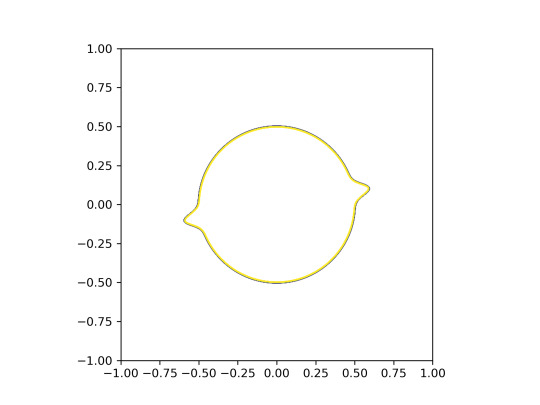
Lemon curves (name courtesy of my fabulous sister @mrunmione) - the shape used to model a cricket ball
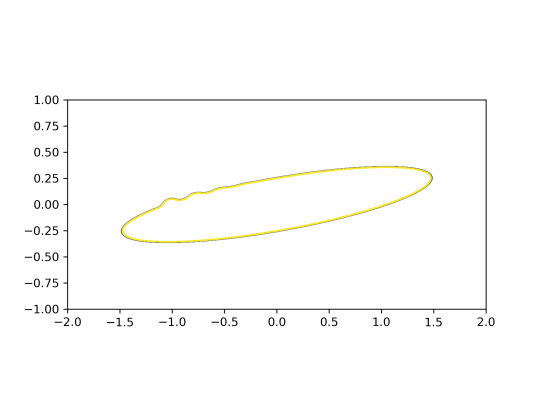
Crocodile curves (because they literally look like crocodiles)
Why are they important? ↓
It is important that when you model obstacles, you do so with at least second-differentiable functions, which means that they can be differentiated at least twice without behaving badly.
This is due to the nature of equations used to model fluids, called the Navier Stokes equations, which is based on Newton's 2nd law of motion, the force applied on an object is proportional to the acceleration (which is where the 2nd derivative comes into play).
70 notes
·
View notes
Text
Computational fluid dynamics



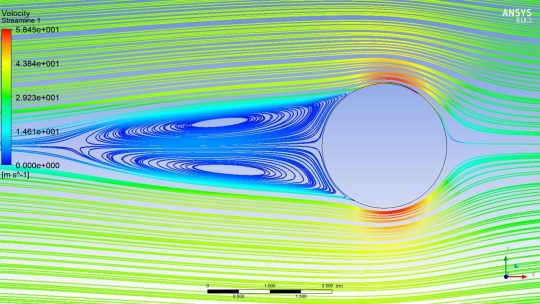
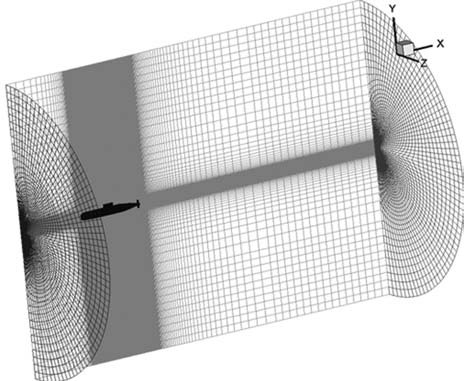
Ansys CFD simulations === contemporary art, fight me
#computational fluid dynamics#simulation#Ansys#contemporary art#modern art#postmodernism#graphic design#inspiration
4 notes
·
View notes
Text
youtube
This video showcases my second attempt at generating a vortex street behind a NACA 4-digit airfoil. The airfoil is pitched to a nose-up orientation, corresponding to an Angle of Attack (AoA) of 30 degrees. For this iteration, I have used a higher value of 'max camber' variable for a more pronounced vortex shedding simulation.
#gas dynamics#aerodynamics#computational fluid dynamics#fluid simulation#lattice boltzmann method#wind tunnel#vorticity#airfoil#particle simulation#Youtube
1 note
·
View note
Text
Computational Fluid Dynamics - SgurrEnergy
Computational Fluid Dynamics (CFD): Accurate simulations for the most optimum design solutions
The design of the Module Mounting Structure (MMS) is primarily governed by wind loads and hence, precise evaluation of wind loads and pressure distribution is an important task in the optimization of the MMS structure. The optimization of MMS is a challenging task following traditional analysis methods and codal provisions, but SgurrEnergy has achieved this with the help of an advanced engineering approach like CFD analysis. The overall cost of MMS on a plant basis can be optimized by providing adequate MMS based on wind effects. CFD analysis helps to find out the effect of wind load on MMS tables and to understand the behaviour of wind on MMS to optimize the design. Computational methods are often more efficient than the experimental approach, as the change of geometry in numerical simulation is quick and easy, unlike for experimental studies, with the same level of precision. CFD solves equations for conservation of mass, momentum, energy, etc., and provides detailed information on the fluid flow behaviour, distribution of pressure, velocity, temperature, etc. The Ansys CFD tool is used to perform the analysis on multiple rows of tables and to simulate the reduction of wind pressure on internal MMS rows.
0 notes
Text
Understanding CFD in Heat Exchanger Design: A Case Study
In modern engineering, Computational Fluid Dynamics (CFD) is vital for optimizing thermal systems. This blog explores a recent CFD thermal analysis performed by Graphler Technology Solutions to evaluate a heat exchanger’s efficiency in transferring heat from a hot fluid (MSW slurry) to a cold fluid (DM water). Here’s what the study uncovered:
The Study Setup
The analysis simulated the heat transfer dynamics between two fluids using steady-state Conjugate Heat Transfer (CHT) analysis. Key parameters included:
Hot fluid (MSW Slurry): Initial temperature of 400°C, flow rate of 0.5 LPM, and inlet pressure of 300 Bar.
Cold fluid (DM Water): Initial temperature of 10°C, flow rate of 38.61 LPM, and inlet pressure of 2 Bar.
The system comprised four heat exchange passes, designed to ensure progressive heat transfer and achieve target temperature levels.
Key Findings
Temperature Distribution
In Pass 1, the hot fluid’s temperature dropped significantly from 400°C to 29.86°C.
Subsequent passes refined the output temperature, with Pass 4 reaching equilibrium at ~10°C.
Heat Transfer Efficiency
The cold fluid flow rate was 77 times higher than the hot fluid��s, driving an aggressive temperature drop.
The heat exchanger required approximately 9–10 meters to align the hot fluid’s temperature with that of the cold fluid.
Material Effectiveness
Stainless steel (Grade 304) and rockwool insulation ensured thermal integrity, with average heat transfer coefficients of:
Cold fluid side: 1027 W/m²-K
Outer insulation: 454 W/m²-K
Energy Implications
The design successfully minimized thermal losses while maintaining the structural and thermal stability of the exchanger.

Material Selection: The use of rockwool insulation and stainless steel proved effective. For future designs, these materials should remain standard, especially for similar operational conditions.
Flow Rate Optimization: High cold fluid flow rates were critical to achieving rapid heat exchange. Depending on energy costs, optimization between flow rates and exchanger length can be explored.
Length Considerations: A total pipe length of 18 meters, with four sequential passes, was adequate for the temperature targets. This insight aids in reducing unnecessary material and space usage in similar designs.

Reach out Graphler technology for a CFD Consulting Services .We are also specialized in Stress Analysis Services , Structural Design Services and more.
0 notes
Text
Master CFD with hands-on training in MATLAB, OpenFOAM, ANSA, CONVERGE, GT-POWER, and more! Learn to write solvers, simulate advanced problems, and improve engine performance.
0 notes
Text
I know everyone here hates ai art, but ai science is really freaking important.
Like, ai done right basically makes p=np for, like, a lot of (formerly) really hard problems, and that's, like, a really big deal. Like, for real.
#ai#science#math#p=np#unpopular opinion#computational fluid dynamics#nuclear design optimization#fusion tokamak control#protein folding predictions#pharmaceutical discovery
1 note
·
View note
Text

Check out this #CFD simulation of a BMW z3’s aerodynamics! 🌬️🚗 Visualizing pressure distribution and airflow streamlines—notice the high pressure at the front and turbulent wake at the rear. Optimizing this can reduce drag and boost efficiency! Details here: https://fetchcfd.com/view-project/192-bmw-z3-simulation
0 notes
Text
#Computational Fluid Dynamics#Aerospace Engineering#Aeroacoustics#Aerospace Propulsion#Aerodynamic Analysis#CFD Applications in Aerospace#Shock-Boundary Layer Interaction#Aeroelastic Analysis#Combustion Modeling#High-Speed Flow Analysis#Turbofan Engine Simulation#Drag Reduction Techniques#Aerospace Vehicle Design#Numerical Simulation in Aerospace#Flow Field Optimization
0 notes
Text
Resolution Effects on Ocean Circulation
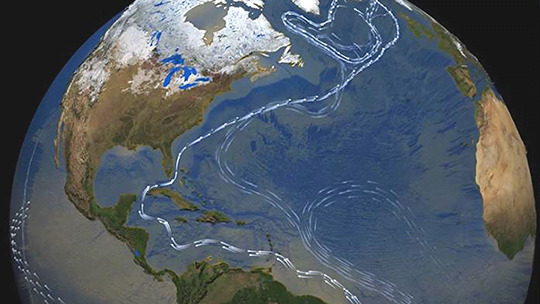
The Gulf Stream current carries warm, salty water from the Gulf of Mexico northeastward. In the North Atlantic, this water cools and sinks and drifts southwestward, emerging centuries later in the Southern Ocean. Known as the Atlantic Meridional Overturning Circulation (AMOC), this circulation is critical, among other things, to Europe's temperate climate. (Image credit: illustration - Atlantic Oceanographic and Meteorological Laboratory, simulations - R. Gou et al.; research credit: R. Gou et al.; via APS Physics) Read the full article
#CFD#circulation#climate change#computational fluid dynamics#flow visualization#fluid dynamics#numerical simulation#ocean currents#oceanography#physics#science
79 notes
·
View notes
Text
the only feeling worse than clicking on something for it not to do anything, is seeing something loading when you didn't click on anything
#cfd#coding#i assume all people who have spent more than 7 comcentrated hours in front of a computer have felt this#WHY ARE YOU LOADING#I DIDNT TOUCH YOU#computational fluid dynamics#aerospace
2 notes
·
View notes
Text

Our efficient prototyping services turn concepts into tangible models for seamless testing and refinement. Ensure quick polished, tangible designs.
#Prototyping#Rendering And Animation#3D Prototype in Mumbai#Finite Element Analysis#Computational Fluid Dynamics
0 notes
Text
youtube
This video presents a frame capture of a Lattice Boltzmann simulation illustrating the formation of von Kármán vortex streets behind a cylindrical bluff body. OpenGL-based particle rendering is used to enhance the visual representation of the flow dynamics.
#gas dynamics#aerodynamics#computational fluid dynamics#lattice boltzmann method#von karman vortex street#vorticity#vortices#wind tunnel#particle simulation#Youtube
1 note
·
View note
Text
1 note
·
View note